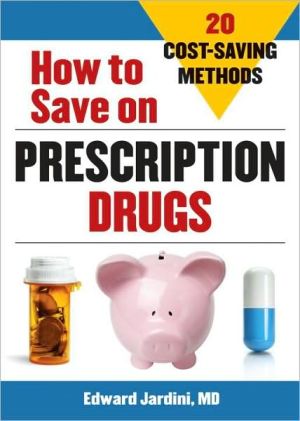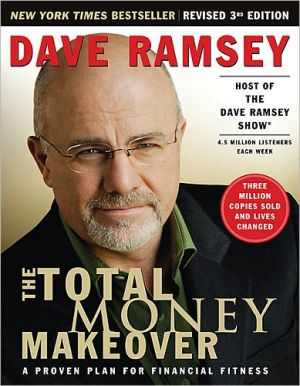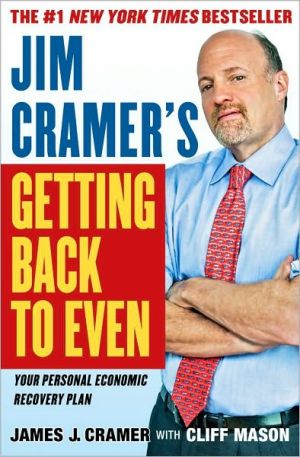How to Save on Prescription Drugs: 20 Cost Saving Methods
New physician-recommended ways to save thousands of dollars per year on prescription drugs.\ With the pharmaceutical industry spending $8 billion per year on direct marketing to physicians, everyone winds up paying the bill through escalating prescription costs. This handbook gives patients the tools they need to become informed consumers and work with their doctors to reduce their prescription drug regimen expenses. Providing useful tips like eliminating unnecessary medications, resisting...
Search in google:
New physician-recommended ways to save thousands of dollars per year on prescription drugs.With the pharmaceutical industry spending $8 billion per year on direct marketing to physicians, everyone winds up paying the bill through escalating prescription costs. This handbook gives patients the tools they need to become informed consumers and work with their doctors to reduce their prescription drug regimen expenses. Providing useful tips like eliminating unnecessary medications, resisting samples, substituting generic drugs, and splitting higher-dose tablets, physician Edward Jardini helps patients take charge of their own health, prescriptions, and wallets. ReviewsRead what Consumerist.com has to say! http://consumerist.com/5032933/14-ways-to-save-on-drugs-big-pharma-doesnt-want-you-to-know-Consumerist.com
How to Save on PRESCRIPTION DRUGS\ 20 COST-SAVING METHODS \ \ \ By Edward Jardini \ CELESTIAL ARTS \ Copyright © 2008 \ Edward Jardini\ All right reserved.\ \ ISBN: 978-1-58761-331-9 \ \ \ \ \ Chapter One The Treatment Review visit \ "Why can't you doctors prescribe drugs your patients can afford?"\ The question did not come from a patient, but rather from a pharmacist friend who works at our local Wal-Mart. He was talking about how his customers react when confronted with the cost of prescriptions. "I've seen people take items out of the basket so they'll have enough to cover their medicines," he went on. "Sometimes they ask me, 'Which ones should I get?' because they can't afford to buy them all."\ A patient of mine summarized the reality of prescription drug purchases for many when she stated plainly, "I buy what I can afford to pay for." The problem is not uncommon. In a nationwide survey of more than four thousand patients over age fifty, 18 percent reported taking less than their prescribed dose of medication due to cost. Twenty-two percent cut back on essentials, including food, to pay for prescription drugs. Amazingly, 84 percent of these patients had some type of prescription benefit plan! Even more disturbing were the results that only 16 percent reported being asked by a doctor or nurse whether they could afford their medications. These statistics reflect the sorry state of affordability of medications for many people in this country. Worse, they show just how unaware American physicians are about their patients' ability to pay for the drugs they prescribe.\ Doctors are expected to keep up with medical advances. Our licenses and specialty status depend on completion of a certain amount of continuing medical education. This is the way we keep current on the latest, most effective treatments including the "drugs of choice" for each disease. But rarely is there any discussion of the financial burden to patients. There seems to be an underlying notion among the medical community that somehow all of the marvelous new treatments will be available to everyone.\ In a January 2006 letter to the Los Angeles Times, Dr. Larry S. Fields, president of the American Academy of Family Practice, wrote, "In my practice I treat many seniors with chronic conditions requiring medication, often expensive medication. Some of my patients have tapped their savings to cover the cost of medication. Others have gone without, with serious implications." This admission by a notable physician was offered as testament to the validity of the new Medicare prescription drug program, but it caused me to wonder, "Why was Dr. Fields prescribing medicines that his patients could not afford? Was he unaware of the discrepancy between their means and the cost of treatment?"\ A young woman with insulin-dependent diabetes returned to a family practice colleague after consultation with a specialist. The patient was in tears. She told my colleague that the specialist had outlined a treatment plan that the young woman couldn't possibly afford. And she had health insurance! What good was the specialist's expertise if the patient received no benefit? Yet he probably completed his day feeling satisfied that he had given the most up-to-date treatment advice to each of his patients. Why didn't he know this patient might not be able to afford it? Well, for one thing, she didn't tell him.\ Who will reveal the truth to doctors about prescription costs? Who is going to teach us to consider patient means when prescribing drug therapy? It certainly won't be our medical journals, which are almost entirely sponsored by the drug companies; leaf through the first twenty pages of any copy of the New England Journal of Medicine and you will see page after page of advertising for expensive prescription drugs. It isn't going to be the AMA; they are more concerned with doctors' financial health than patients'. It's not going to be the Surgeon General or the Department of Health and Human Services, nor will it be the university medical centers or the National Institutes of Health. They've all had their chances, and look where we are today: one of five elderly Americans choosing between food and medicine. Who, then?\ You.\ Patients like you are going to do it. Visit by visit, one doctor at a time, patients are going to bring the message that drug treatment must be tailored to their ability to afford it. Remember that medicine is a service industry and that your doctor works for you. Directly or indirectly, your doctor is paid for the service he provides to you. Wouldn't you tell a hired serviceman if he was not doing a good job? If you cannot pay for the treatment your doctor recommends or have to sacrifice essentials to get it, you are not getting your money's worth at the office visit; he is not giving you good service.\ It is certainly not my intention to create animosity between you and your doctor-quite the opposite. I am trying to break through traditional barriers that might prevent you from obtaining reasonably priced medical care. People are usually quite respectful of physicians, particularly at their appointments. The doctor is a knowledgeable, authoritative figure. How could you possibly question his recommendations? The answer is simple: just remember he works for you. Instead of crying to her family doctor, the young diabetic woman should have informed the specialist as soon as she realized she could not afford his treatment plan. Dr. Fields' patients likewise should have protested his medication choices. Most patients have never confronted a doctor in that way. Many would be embarrassed or afraid to do so. But this chapter will show you how to approach your doctor-your service provider-in order to obtain affordable treatment.\ Train Your Doctor to Work for You\ To economize treatment, you need to form a partnership with your doctor-a collaboration that strives for the best possible health care at a reasonable price. This alliance might be initiated at any office appointment, but I recommend a dedicated consultation I call the treatment review visit. Let's face it; the doctor's day is unpredictable and disrupted by urgent situations and unexpected emergencies. This is partly why you languish so long in the waiting room. If you try to add a discussion of medication costs to your usual visit, you may be slighted. There just isn't enough time for the doctor to make an assessment of ongoing problems, perform an examination, evaluate and treat new concerns, and also make a meaningful appraisal of treatment costs. A comprehensive review of medications is fundamental and should not be rushed. If it enables you to afford treatment, it is worth a dedicated visit, and you will need to make a specific appointment to start the process.\ Get Ready to Save\ Schedule an appointment with your doctor to review your medications. Don't attempt to initiate treatment changes with phone calls, faxes, letters, or emails. Treatment changes are too elaborate for those forms of communication. Fostering an affordable health alliance requires an intimate dialogue that only a face-to-face office visit can provide. Insist the visit be with your usual doctor, not a partner or associate, nurse, or physician's assistant. Request an adequate amount of time for the visit, at least thirty minutes for every two or three expensive drugs you take. Make the receptionist aware that the purpose of the appointment will be only to review treatment and medication costs.\ Before the visit, you must prepare. Like an attorney giving arguments at trial, you will make your case for affordable treatment, and you must be ready. First, add up your current prescription costs. Then determine a medication budget (see chapter 2), and be ready to show the shortfall. Next, prepare suggestions for changes to the treatment plan with the projected savings. These are explained in the cost-saving methods and case studies in the following chapters.\ Conducting a Treatment Review Visit\ When the doctor arrives, quickly let her know that you do not want an examination but are only there to discuss your medications. Impress upon her your present medication costs and what your budget will allow. Tell her you appreciate that each medication has been carefully chosen, but make it clear that the present regimen is not acceptable.\ "I need your help, doctor," is a great way to start. "I cannot afford the drugs you prescribe."\ If it's true, admit that you've skipped or reduced doses or have gone without essentials due to the cost.\ "I never filled the prescription for Advair because it costs over $200 a month!"\ This statement emphasizes the urgency and gives grounds that something must change. Don't let her off the hook if she offers free drug samples! Counter with this:\ "Unless you can guarantee a lifetime supply, those samples won't solve my problem."\ Then tell her you'd like to streamline treatment by eliminating medicines that are no longer necessary:\ "Doc, we keep adding new drugs for blood pressure, diabetes, and cholesterol, but we never get rid of any. Is every drug I take necessary?"\ Anyone taking four or more medicines should definitely start with a similar question. This forces your doctor to focus on management of complicated long-term medical problems, considering the value of each drug at the present point in time. Hopefully, therapies that are no longer beneficial are recognized and eliminated. Start the analysis with questions such as, "The test showed that my duodenal ulcer was healed a year ago. Is there any reason to continue the Nexium?" or, "It's been more than a year since I felt depressed. Shall we try weaning me off Cymbalta now?" You can also request confirmation of a diagnosis or that a particular drug was ever necessary. Don't be shy; it's your health and your money.\ "My previous doctor started me on Singulair. It's quite expensive, and I'm not sure why I take it. Is it really necessary?"\ This statement would have served Greta Barker well. She was a new patient taking Singulair along with thirteen other prescription drugs. Singulair is a costly second-line therapy for resistant cases of asthma and allergies, but Greta had neither condition. Records showed that a hospital doctor started the drug while she was under treatment for pneumonia. She was sent home with a prescription her family doctor continued to refill, costing her $338 every three months. With supervision, Greta stopped taking Singulair without any ill effect to her health but with substantial benefit to her bank account! (Cost-saving method 4.)\ You could just say your medications are too expensive and ask about alternatives. However, you are more likely to engage the physician if you offer specific proposals. This is also your opportunity to begin your doctor's education in economical prescribing! Single out an expensive medication and show her a cost-saving method:\ "The 10 mg Lexapro tablets cost $300 for ninety tablets. Splitting a 20 mg tablet cuts the cost in half and saves me $600 a year!" (Cost-saving method 13.)\ "Generic metoprolol twice a day instead of brand-name Toprol-XL is one-tenth the cost! Switching to the generic would save me over $350 a year." (Cost-saving method 10.)\ "The Norvasc controls my blood pressure, but $220 for a three month supply is outrageous. I understand a diuretic can work as well or better at just pennies per pill." (Cost-saving method 12.)\ "The neurologist prescribes me three 100 mg Neurontin capsules to take at a time. A single 300 mg capsule provides the same dose of the same drug and saves $415 a year!" (Cost-saving method 14.)\ "Could we try changing my cholesterol drug from Lipitor to generic lovastatin? That would save me over $1,000 a year." (Cost-saving method 11.)\ "I understand that treatment of women with a bone density T-score above -2.5 with Fosamax has shown little to no benefit in prevention of fractures. I'd rather save the $1,200 a year and continue with nonprescription prevention." (Cost-saving method 7.)\ These proposals may sound too sophisticated for you to make, but believe me, they are not. The chapters that follow will show you how to do it. You only need to know how the cost-saving methods apply to your treatment, not to every medical therapy.\ Your doctor may approve a proposed treatment change or suggest an alternative plan. Keep an open mind and respect her counsel. Some of your ideas may not be suited to your particular case. Your doctor needs your input on medication costs, but you need her expertise in medical management. It is also wise not to make too many changes at once; one at a time is best. That way, if you experience an adverse effect, you can deduce what change in therapy caused it.\ By the end of the initial treatment review visit, you will have delivered a powerful message. I guarantee your doctor will not forget this encounter. From that day forward she will respect your need for economy in prescribing and begin to treat more reasonably with drugs.\ Follow-Up\ When changes are made, request timely follow-up to assess results and make adjustments. If a change of therapy doesn't work out, perhaps due to an adverse reaction, do not be discouraged. And don't be too anxious to go back to the original treatment, the one you couldn't afford. Remember that prohibitive cost is an intolerable side effect too. There are usually multiple alternatives to treatment with an expensive drug. If a cheaper medication causes side effects, try the next option. Eventually you will arrive at a well-tolerated, effective, and affordable treatment.\ Within three months, Greta Barker's drug costs were brought under control. Her medication list was reduced from 14 to 7 drugs, and her monthly pharmacy bill dropped from $1,290 to $170, a savings of more than $13,000 per year.\ The cost-saving methods are explained simply and thoroughly in the chapters that follow. Case studies give practical examples of affordable alternatives to the most popular, expensive drugs. As you read, jot down ideas and proposals for cutting costs that apply to your treatment. Ultimately, you will be ready to begin training your doctor to prescribe treatment that you can afford.\ Chapter Two Budgeting Prescription Costs\ Primum non nocere. (First, do no harm.) -Hippocrates (circa 460-377 B.C.E.)\ At the time your doctor recommends treatment with medication, it is quite likely that neither of you have any idea what it costs. Starting a patient out with a bagful of drug company samples of uncertain retail price is unconscionable. This common practice completely removes the doctor from any financial discussion. The unfortunate patient then stands alone in shock at the drugstore counter when he ultimately has to buy more pills. Where is the doctor-patient relationship at that moment of revelation? When the physician does not know how much a new treatment is going to cost, and the patient unwittingly accepts it, I call it idiopathic prescribing: the patient is pathetic, and the doctor is an idiot!\ Your doctor may be a brilliant clinician with knowledge of the latest clinical studies and all the newest drugs. Nevertheless, if he prescribes treatment that needlessly punches a large draining hole into your savings account, you should consider a divorce. The familiar doctor's motto, "First, do no harm," should also apply to the patient's wallet. Physicians have an obligation to make reasonable recommendations. This includes affordable prescribing.\ What's It Gonna Cost?\ As a patient, you are also a consumer. You must check the price tag before heading to the checkout counter. When your doctor recommends a new therapy with a prescription drug, find out what it costs. A vague response from the physician is not adequate. If the doctor doesn't know the price, show him how to get it! Prices can be quickly found at CVS.com or another online website. Everybody has cellular telephones these days. (Many patients think nothing of taking a call during my examination!) Why not call the local drugstore before leaving the office? That will get the doctor's attention! You could get the bad news at the drug store, but if the price is unacceptably high, you are left with the hassle of calling the office, leaving a message with the staff, waiting for a return call, and so on. You know the routine. And the next prescription may be more expensive than the first! No, it is better to discuss every facet of a new treatment face to face with the doctor, including the expense. Be adamant. Tell her, "Doctor, before I can start this medication, I must know the cost." If you are already overburdened with medication costs, the methods described later in this book will help. But first you must determine a prescription budget.\ (Continues...)\ \ \ \ \ Excerpted from How to Save on PRESCRIPTION DRUGS by Edward Jardini\ Copyright © 2008 by Edward Jardini. Excerpted by permission.\ All rights reserved. No part of this excerpt may be reproduced or reprinted without permission in writing from the publisher.\ Excerpts are provided by Dial-A-Book Inc. solely for the personal use of visitors to this web site.\ \
Contents ACKNOWLEDGMENTS....................viINTRODUCTION....................11 THE TREATMENT REVIEW VISIT....................92 BUDGETING PRESCRIPTIONS COSTS....................193 ELIMINATE NONESSENTIAL PRESCRIPTIONS: COST-SAVING METHODS 1 THROUGH 4....................234 THINK OUTSIDE THE PRESCRIPTION DRUG BOTTLE: COST-SAVING METHODS 5 THROUGH 7....................465 STEER CLEAR OF OVERPRICED REDUNDANT DRUGS: COST-SAVING METHODS 8 THROUGH 12....................746 PLAY IT SMART! COST-SAVING METHODS 13 THROUGH 17....................1287 PROGRAMS FOR PILLS: COST-SAVING METHODS 18 THROUGH 20....................162A NOTE ON EXPIRATION DATES....................193AFTERWORD: MAKE THIS BOOK OBSOLETE....................199APPENDIX: EXPENSIVE-DRUG SURVIVAL INDEX....................201ENDNOTES....................229GENERAL INDEX....................241








